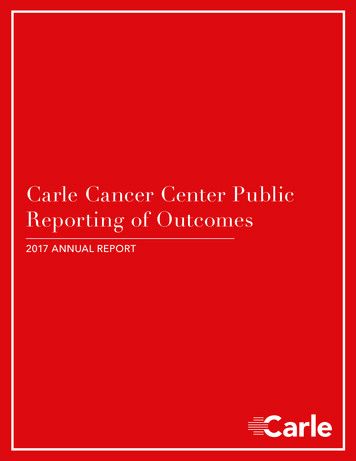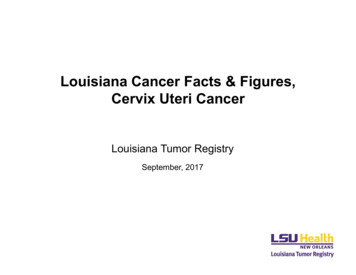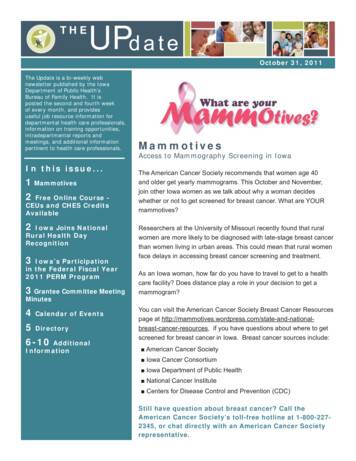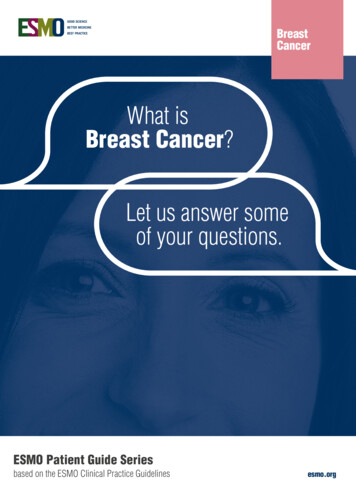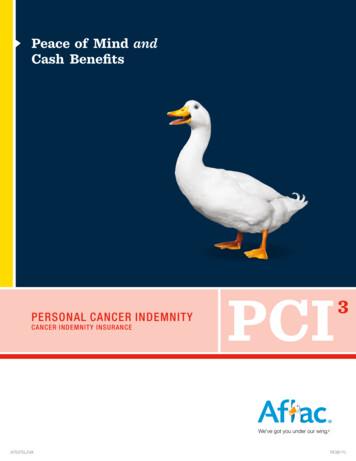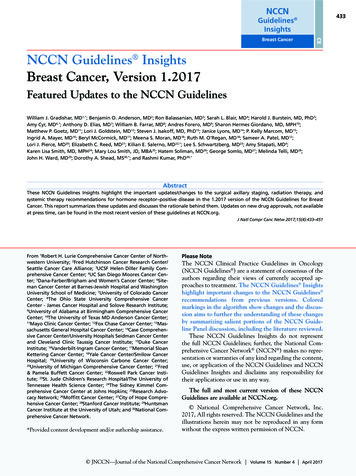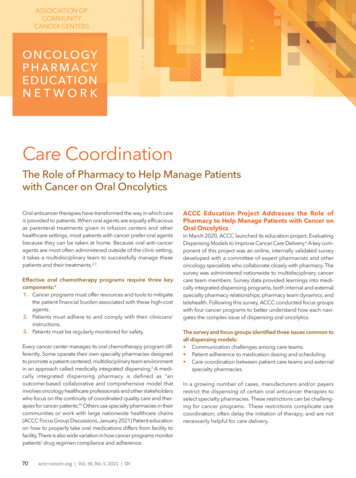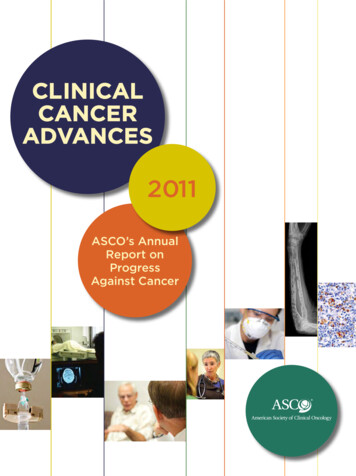
Transcription
ClinicalCancerAdvances2011ASCO’s AnnualReport onProgressAgainst Cancer
EditorsEXECUTIVE EDITORSNicholas J. Vogelzang, MD, U.S. Oncology Research, Comprehensive Cancer Centers of NevadaMark G. Kris, MD, Memorial Sloan-Kettering Cancer CenterSPECIALTY EDITORSSylvia Adams, MD, New York University Cancer InstituteCarol Aghajanian, MD, Memorial Sloan-Kettering Cancer CenterSusan Marina Chang, MD, University of California at San FranciscoZoAnn Eckert Dreyer, MD, Texas Children’s Cancer Center, Baylor College of MedicinePasi A. Jänne, MD, PhD, Dana-Farber Cancer InstituteAndrew H. Ko, MD, University of California at San Francisco Comprehensive Cancer CenterGregory A. Masters, MD, FACP, Helen F. Graham Cancer CenterOlatoyosi Odenike, MD, University of ChicagoJyoti D. Patel, MD, Northwestern UniversityBruce J. Roth, MD, Washington University in St. Louis School of MedicineWolfram E. Samlowski, MD, Comprehensive Cancer Centers of NevadaAndrew D. Seidman, MD, Memorial Sloan-Kettering Cancer CenterWilliam D. Tap, MD, Memorial Sloan-Kettering Cancer CenterJennifer S. Temel, MD, Massachusetts General HospitalJamie H. Von Roenn, MD, Robert H. Lurie Comprehensive Cancer Center of Northwestern UniversityASCO PRESIDENTMichael P. Link, MD, Stanford UniversityASCO PRESIDENT-ELECTSandra M. Swain, MD, Washington Hospital CenterASCO CHIEF EXECUTIVE OFFICERAllen S. Lichter, MD
Clinical CancerAdvances 2011ASCO’sAnnualReport onProgressAgainstCancerA LETTER FROM ASCO’S PRESIDENT2EXECUTIVE SUMMARY3CANCER RESEARCH ADVANCES7Blood and Lymphatic CancersBreast CancersCentral Nervous System TumorsGastrointestinal CancersGenitourinary CancersGynecologic CancersLung CancersMelanomaSarcomasAdvanced Cancer CareCancer DisparitiesDevelopmental TherapeuticsPatient and Survivor CarePediatric CancersPrevention and Screening7912141518212426273033343536A YEAR IN REVIEW40Guidelines AND New Therapies43ASCO Resources44
A Letter from ASCO’s PresidentIt has been 40 years since U.S. President Richard Nixon signed the National Cancer Act of 1971, which many viewas the nation’s declaration of the “war on cancer.” The bill has led to major investments in cancer research andsignificant increases in cancer survival. Today, two-thirds of patients survive at least five years after being diagnosedwith cancer, compared to just half of all diagnosed patients in 1975.The research advances detailed in this year’s Clinical Cancer Advances report demonstrate that improvements incancer screening, treatment and prevention are saving and improving lives. But while much progress has beenmade, cancer remains one of the world’s most serious health problems. In the United States, the disease is expectedto become the nation’s leading cause of death in the years ahead, as our population ages.I believe we can accelerate the pace of progress, provided that everyone involved in cancer care works together toachieve this goal. It is this viewpoint that has shaped the theme for my presidential term: Collaborating to ConquerCancer. In practice, this means that physicians and researchers must learn from every patient’s experience, ensuregreater collaboration between members of the patient’s medical team, and involve more patients in the search forcures through clinical trials. Cancer advocates, insurers and government agencies also have important roles to play.Today, we have an incredible opportunity to improve the quality of cancer care by drawing lessons from thereal-world experiences of patients. ASCO is taking the lead in this area, in part through innovative use of healthinformation technology. In addition to our existing quality initiatives, ASCO is working with partners to develop acomprehensive “rapid learning system” for cancer care. When complete, this system will provide physicians withpersonalized, real-time information on the care of every patient with cancer, while also connecting patients and theirentire medical teams. The rapid learning system will form a continuous cycle of learning—securely capturing datafrom every patient at the point of care, drawing on evidence-based guidelines, and evaluating quality of care againstthose standards and the outcomes of other patients.Clinical trials are another area where collaboration is critical. Increasing clinical trial participation will requirecommitment across the cancer community—from physicians, patients, insurers, hospitals and industry. A 2010report by the Institute of Medicine (IOM) described challenges to participation in trials by both physicians andpatients and provided recommendations for revitalizing clinical trials conducted through the National CancerInstitute’s Clinical Trials Cooperative Group Program. ASCO has pledged its support for the full implementation ofthese recommendations.More broadly, ASCO recently outlined a bold vision for translational and clinical cancer research over the nextdecade, and put forth recommendations to achieve that vision. ASCO’s Blueprint for Transforming Clinical andTranslational Research, released in November, calls for a research system that takes full advantage of today’sscientific and technological opportunities, and sets a high-level agenda for policymakers, regulators and advocates.Cancer research has transformed cancer care over the past 40 years, and this Clinical Cancer Advances reportillustrates how far we have come in the past year alone. We now have a tremendous opportunity to utilize today’sknowledge and collaborate across all facets of cancer care to conquer this deadly disease.Michael P. Link, MDASCO President2
Executive SummarySUMMARY OF FINDINGSEach year, the American Society of Clinical Oncology conducts an independent review of advances in cancer research that have the greatest potentialimpact on patients’ lives. This year, Clinical Cancer Advances 2011 features54 significant studies, including 12 that the report’s editors consider majoradvances.This year’s Clinical Cancer Advances report also recaps the year’s most important cancer policy developments and ASCO policy initiatives that are likelyto influence cancer care over the coming years. These include developmentsthat could help to accelerate the pace of clinical cancer research progress andensure access to quality cancer care for patients.1. Screening and PreventionWith cancer, the ultimate goal isto avoid the disease altogether.Smoking cessation efforts, lifestylechanges, and other biomedical interventions have successfully preventedthousands of cancers over the pastdecades.At the same time, researchers seekbetter ways to detect cancers early,when they are most curable. Screening advances are credited with improving survival rates for a range ofcancers. Notable advances in cancerscreening and prevention of the pastyear include:Low-Dose CT Scanning Reduces Lung Cancer Death Ratein People at High RiskA national screening trial of more than 50,000 current- and former-heavy–smokers found that three annual low-dose computed tomography (CT) scansreduced the risk of dying from lung cancer by 20 percent compared to thosewho were screened with three annual chest X-rays. This landmark trial was thefirst to identify a screening regimen for patients at high risk for lung cancer,despite decades of attempts. Guidance on how to apply these findings is expected over the coming year.Exemestane Reduces Risk of Invasive Breast Cancer in High-Risk,Postmenopausal WomenA phase III trial showed that exemestane (Aromasin ), a member of a familyof drugs called aromatase inhibitors, reduced the risk of developing breastcancer compared with placebo in high-risk, postmenopausal women. This isthe first conclusive evidence that an aromatase inhibitor reduced the risk of afirst breast cancer, making exemestane an option for postmenopausal womenwho are at high risk for the disease. Two other drugs, tamoxifen and raloxifene,are already approved for this purpose but carry with them concern over sideeffects that deter many women who could benefit from such treatment.3
2. HARD-TO-TREAT CANCERSWhile some cancers respond well to treatment, other forms of the disease aremore resistant. Melanoma, ovarian cancer and neuroblastoma all fall into thislatter group. In many cases, current therapies can induce remissions or stallthe disease’s progression for long periods of time, but these cancers still toooften persist and grow.Progress in these in the past year includes:BRAF Inhibitor Improves Survival in Advanced Melanoma,Gains FDA ApprovalA phase III trial showed that the drug vemurafenib (Zelboraf ), which targetsa common mutation in melanoma in a gene called BRAF, improved overallsurvival in patients with advanced melanoma when compared to standardchemotherapy. About half of patients have tumors that carry this mutation.Vemurafenib—which received FDA approval in August 2011—is a new standard treatment for patients with melanoma and this gene mutation, helping tousher in a personalized approach to treating the disease.ABOUT CLINICAL CANCER ADVANCESClinical Cancer Advances serves to fill a gap in cancer literature by publishingthe major advances in clinical cancer research and care each year. The American Society of Clinical Oncology developed this annual report, now in its seventh year, to document the important progress being made in cancer researchand to highlight emerging trends in the field.Developed under the direction of an 18-person editorial board comprisedof prominent oncologists, only studies that significantly altered the way acancer is understood or had a direct effect on patient care were included. Theeditors—including specialty editors for each of the disease- and issue-specificsections—reviewed research presented at major scientific meetings and studiespublished in peer-reviewed scientific journals over a one-year period (October2010-September 2011).The advances detailed in each section are categorized as “major” and “notable,” depending on their impact on patient care and survival. The researchFirst-Line Ipilimumab PlusChemotherapy Improves Survivalin Metastatic MelanomaA phase III study found that treatment with ipilimumab (Yervoy )—animmune therapy that activates theimmune system’s T cells—combinedwith the standard chemotherapydrug dacarbazine improved overallsurvival by 2 months in patients withpreviously untreated metastatic melanoma, compared to chemotherapyalone. This is the first study showingthe benefit in prolonging life of combining chemotherapy and immunotherapy in patients with advancedmelanoma.considered for this report covers the full range of clinical cancer issues: epidemiology, prevention, screening, early detection, traditional treatment (surgery, chemotherapy, radiation), targeted therapies, immunotherapy, geneticresearch, developmental therapeutics, personalized medicine, access to care,quality of life, and end-of-life care.This report is intended for anyone with an interest in cancer care, includingthe general public, news media, patients, caregivers, oncologists, nurses, policymakers, advocacy organizations, and other medical professionals.ABOUT ASCOThe American Society of Clinical Oncology (ASCO) is the world’s leading professional organization representing physicians who care for people with cancer. With more than 30,000 members, ASCO is committed to improving cancercare through scientific meetings, educational programs and peer-reviewedjournals. ASCO is supported by its affiliate organization, the Conquer CancerFoundation, which funds ground-breaking research and programs that makea tangible difference in the lives of people with cancer. For ASCO information and resources, visit www.asco.org. Patient-oriented cancer information isavailable at www.cancer.net.4Bevacizumab Delays Progressionin Recurrent Ovarian CancersTwo randomized phase III trialsfound that bevacizumab (Avastin )—a monoclonal antibody that inhibitsblood vessel growth and development in tumors—together with standard chemotherapy helped womenwith recurrent ovarian cancer livesignificantly longer without their disease worsening than those treatedwith the same chemotherapy alone.In the first trial, called OCEANS, patients treated with bevacizumablived a median of four months longerwithout the disease progressing thanthose who received chemotherapyalone—a 52 percent reduction in therisk of disease progression.
In the second trial, data suggested thatadding bevacizumab to standard carboplatin and paclitaxel chemotherapy for treatment of newly diagnosed ovarian cancerhelps women live longer than with treatment with chemotherapy alone, particularlyfor patients with more aggressive forms ofthe disease. By extending the time patientscan live without disease progression—andwithout further treatment with chemotherapy—these results suggest that increasingly, ovarian cancer may be treated as alonger-term, chronic disease. Researchersawait longer-term data from both studiesto get a clearer picture of how these regimens improve survival, and which womenbenefit most.New High-Dose Chemotherapy Regimen Improves Survival in Childrenwith Hard-to-Treat NeuroblastomaA phase III trial showed that a new combination of chemotherapy drugs improved survival for children with high-risk metastatic neuroblastoma. Afterthree years, the event-free survival rate for patients treated with an intensedosing of the chemotherapy drugs busulphan-melphalan was 49 percentcompared to 33 percent for the three standard chemotherapy drugs, carboplatin, etoposide and melphalan. These findings establish a new standard ofcare for high-risk neuroblastoma, and together with other recent treatmentadvances for the disease, are likely to lead to survival gains for patients.3. REDUCING CANCER RECURRENCEWhile many cancers can be treated successfully at first, preventing the disease from returning is often difficult, particularly when diagnosed at advancedstages. When a cancer recurs, it usually is more resistant to therapy, and maynot be curable. Several studies this year marked important advances in preventing recurrence of a type of leukemia in children and young adults, a formof gastrointestinal cancer, and breast cancer.Three Years of Imatinib Therapy Improves Survival for High-Risk GISTA phase III trial showed that three years of treatment with the targeted kinaseinhibitor imatinib (Gleevec ) after surgery in patients with high-risk gastrointestinal stromal tumors (GIST) significantly improved overall and recurrencefree survival compared to one year of treatment. The findings could result inthe three-year course of therapy becoming the new standard of care for thosepatients who are at risk for relapse.New Chemotherapy Regimen Boosts Event-Free Survival for Childrenand Young Adults with Acute Lymphoblastic LeukemiaA phase III Children’s Oncology Group trial of nearly 2,500 children and youngadults with acute lymphoblastic leukemia (ALL) showed that giving the common chemotherapy drug methotrexate in large, consistent doses—rather thanin the gradually increasing doses of the standard regimen—was more effectivein preventing relapses and extended survival. These findings set a new standard of care, and pushed cure rates for pediatric patients with acute lymphoblastic leukemia to more than 80 percent. This disease was once consideredone of the most deadly pediatric cancers but today is seen as one of the mostcurable.5
Adding Regional Nodal Irradiation Decreases Recurrences in Womenwith Early Breast CancerAn analysis of a randomized phase III trial found that adding radiation to theregional lymph nodes reduces the risk of cancer recurrences both near thetumor and in other parts of the body in women with early-stage breast cancerwho have one to three cancer-positive lymph nodes (or high-risk node-negative breast cancer). The findings are important because women with breastcancer that has spread to the lymph nodes are typically treated with breastconserving surgery and surgery to remove many of the lymph nodes underthe arm, followed by radiation to the entire breast to reduce the likelihood ofrecurrence. The usefulness of expanding the traditional radiation field aroundthe breast in this population of patients had previously been unclear.4. NEW DRUG APPROVALSIn addition to the approval of vemurafenib for melanoma (see earlier summaryin this section), new treatment options were approved by the U.S. Food andDrug Administration for lung cancer and prostate cancer.FDA Approves Crizotinib (Xalkori) for Lung CancerThe FDA approved a new drug, crizotinib (Xalkori ), in August for patientswith advanced non-small cell lung cancer whose tumors harbor a specific typeof alteration in the anaplastic lymphoma kinase (ALK) gene. The drug wasfound to improve survival by 31 percent after two years. The approval of crizotinib is the latest example of a successful personalized medicine approach intreating patients with lung cancer.Abiraterone Acetate Approved for Patients with Prostate CancerIn April, the FDA approved the oral agent abiraterone acetate (Zytiga ) incombination with the drug prednisone for patients with metastatic hormonerefractory prostate cancer who have received prior treatment with the chemotherapy drug docetaxel. Abiraterone acetate works by blocking the productionof male sex hormones (such as testosterone), which fuel the growth of prostate tumors. Since only one other agent, cabazitaxel (Jevtana ), an intravenous chemotherapy drug, has been shown to prolong survival in patients whono longer respond to treatment with docetaxel, this approval represents amuch-needed new option for patients.6
Cancer Research AdvancesBLOOD AND LYMPHATIC CANCERSSpecialty Editor: Olatoyosi Odenike, MDCancers of the blood and lymphatic system include leukemia, lymphoma andmultiple myeloma.This year, several trials of an antibody-drug combination showed tumorshrinkage in the majority of patients with two types of lymphoma. The antibody-drug combination was subsequently approved by the FDA. In addition,study results of another type of drug called a JAK inhibitor showed responsesin patients with myelofibrosis, a potentially deadly bone marrow disorder.Notable AdvancesTrials of Antibody-Drug Combination Show Tumor Shrinkagein LymphomasHodgkin lymphoma and anaplastic large-cell lymphoma (ALCL) are the mostcommon tumors that express the protein antigen CD30 on the cell surface.Previous attempts to target the protein with monoclonal antibodies have beendisappointing.New findings from a trio of trials showed that an antibody-drug combination—brentuximab vedotin (Adcetris )—directed against CD30 increasedtumor responses in patients with both cancers who no longer responded tostandard therapies. Brentuximab consists of an antibody directed against theCD30 protein that is chemically linked to a chemotherapy drug, monomethylauristatin E. Monomethyl auristatin E had previously been tried alone but wasfound to be extremely toxic. The drug combination—termed a “conjugate”—isdesigned to bind and deliver the chemotherapy directly to cells with the CD30protein, which is present only on the cancer cell. This approach concentrateschemotherapy on the cancer cells and spares healthy cells.Based on phase II trial results, the FDA in August 2011 granted acceleratedapproval for brentuximab vedotin for patients with refractory Hodgkin lymphoma and ALCL. Brentuximab vedotin is the first drug ever approved specifically for ALCL, and the first new drug approved by the FDA for Hodgkinlymphoma in more than 30 years.1Briefly, the studies found the following:a phase I multicenter trial, researchers tested the effectiveness of brentuximab in 45 patients with relapsed or refractory CD30-positive hematologic cancers, mostly Hodgkin lymphoma and ALCL. Tumors regressed in 36of 42 evaluable patients (86 percent). 2nnIn one of two phase II trials, 102 patients with relapsed or refractory Hodgkinlymphoma were treated with brentuximab, with 75 percent of patients having tumors shrink to at least half their original size. 3nnIn a phase II trial of 58 patients with ALCL, 87 percent of patients had tumorsshrink to at least half their original size, with 57 percent showing completeremissions.4nnInDiarrhea, fatigue, nausea and peripheral neuropathy were among the mostcommon side effects of the drug combination.7
JAK Inhibitor Improves Response Rate for Patients withHigh-Risk MyelofibrosisThere has been an explosion of newinformation regarding the complexity of themolecular-genetic aberrations underlyinghematologic malignancies in the past decade.An ongoing challenge remains the abilityto decipher which of these mutations aredrivers with regard to disease pathogenesisin the individual malignancy. When we areable to effectively identify and target drivermutations, personalized medicine will trulycome of age in these disorders.—Olatoyosi Odenike, MD8Myelofibrosis (MF), a disorder characterized by scar tissue buildup in the bonemarrow, is extremely difficult to treat. It causes anemia, a variety of debilitating symptoms such as fatigue, night sweats, weight loss and bone pain, and anenlarged spleen, and leads to acute myeloid leukemia and bone marrow failurein more than a quarter of patients.While bone marrow transplantation remains the only potential cure, relatively few of these often elderly patients are eligible. Other therapies, including hydroxyurea, anabolic steroids and thalidomide, lessen symptoms but donot lead to cure.Two randomized phase III trials showed that the Janus kinase (JAK) inhibitor ruxolitinib improved response rates and symptoms of the disease for threeforms of MF. The trials—called COMFORT I and COMFORT II—are the first-everrandomized drug trials for MF. Together, these findings promise to change thestandard of care for many patients with MF.While the median overall survival for myelofibrosis can exceed five years,patients with high-risk forms of the disease only live, on average, about twoto four years after diagnosis. About half of all patients carry a mutation in theJAK 2 gene, although many more may have an active JAK signaling pathway.Ruxolitinib inhibits both JAK 1 and JAK 2.The COMFORT II trial compared ruxolitinib to best available therapy inadults with primary myelofibrosis, post-polycythemia vera-myelofibrosis orpost-essential thrombocythemia myelofibrosis. In the study, 219 patients withintermediate or high-risk disease were randomly assigned to either ruxolitinib(146) or best available therapy (73), with responses measured in terms of a 35percent or greater reduction in spleen size. After 48 weeks, researchers foundthis reduction in spleen size in 28.5 percent of patients receiving the drugcompared to 0 percent in those who did not receive it. 5In the COMFORT I trial, treatment with ruxolitinib was compared to placeboin 309 patients with the same three types of MF. After treatment for a median follow-up of 32 weeks, 42 percent of those who received the drug had a35 percent reduction in spleen size after 24 weeks compared to 1 percent ofpatients taking placebo. The majority of patients receiving ruxolitinib in bothstudies saw improvement in fatigue, night sweats, weight loss and bone pain.6REFERENCES1. FDA approves Adcetris to treat two types of lymphoma. Press release, U.S. Food andDrug Administration. August 19, 2011.2. Younes, A, et al: Brentuximab Vedotin (SGN-35) for relapsed CD30-positive lymphomas.N Engl J Med. 2010; 363:1812-1821.3. Chen, R, et al: Results of a pivotal phase II study of brentuximab vedotin (SGN-35) inpatients with relapsed or refractory Hodgkin lymphoma. Presented at the 52nd AnnualMeeting of the American Society of Hematology; December 2010; Orlando, FL.4. Shustov, AR, et al: Complete remissions with brentuximab vedotin (SGN-35) in patientswith relapsed or refractory systemic anaplastic large cell lymphoma. Presented at the52nd Annual Meeting of the American Society of Hematology; December 2010;Orlando, FL.Blood and Lymphatic Cancers5. Harrison, CN, et al: Results of a randomized study of the JAK inhibitor ruxolitinib (INC424)versus best available therapy (BAT) in primary myelofibrosis (PMF), post-polycythemiavera-myelofibrosis (PPV-MF) or post-essential thrombocythemia-myelofibrosis (PET-MF).Presented at the 47th Annual Meeting of the American Society of Clinical Oncology; June2011; Chicago, ress.net/lymphoma6. Verstovsek, S, et al: Results of COMFORT-I, a randomized double-blind phase III trial ofJAK 1/2 inhibitor INCB18424 (424) versus placebo (PB) for patients with myelofibrosis(MF). Presented at the 47th Annual Meeting of the American Society of Clinical Oncology;June 2011; Chicago, IL.
BREAST CANCERSSpecialty Editor: Andrew D. Seidman, MDThere have been profound changes in recent years for women with breastcancer—the most common cancer among women in the United States—asthose diagnosed with the disease live longer, healthier lives. New insights intobreast cancer development on a molecular level are helping researchers understand and treat the disease as never before.Important advances this year include a study showing a new potential rolefor aromatase inhibitors to reduce the risk of developing breast cancer, and atrial demonstrating the benefit of expanding radiation treatment to the lymphnodes after lumpectomy. Two trials showed the value of combining targeted drugs, together with chemotherapy, in women with stage II and stage IIIHER2-positive breast cancers. Additionally, a randomized trial of a PARP inhibitor proved ineffective in metastatic triple-negative disease, an extremelyaggressive form of breast cancer, despite earlier favorable results.Fact:Since 1990, the number ofwomen who have died of breastcancer has declined steadilyeach year. In women youngerthan 50, there has been adecrease of around 3% per year;in women age 50 and older, thedecrease has been 2% per year.MAJOR ADVANCESExemestane Significantly Reduces Risk of Invasive Breast Cancer inHigh-Risk, Postmenopausal WomenAlthough the anti-estrogen drugs tamoxifen and raloxifene are FDA-approvedfor breast cancer prevention in women at high risk, only 4 percent of the approximately two million women in the United States who could benefit fromthem actually take either drug because of concerns about the increased riskof developing endometrial cancers and blood clots.Over the past year, a phase III trial showed that exemestane (Aromasin )—amember of a family of drugs called aromatase inhibitors—greatly reduces therisk of developing breast cancer in high-risk, postmenopausal women.1 This isthe first evidence that an aromatase inhibitor reduces the risk of a first breastcancer, and now opens the door for exemestane to become an option forpostmenopausal women who are at high risk for breast cancer.Aromatase inhibitors, which work differently than tamoxifen by preventingestrogen synthesis, have been proven superior to tamoxifen in preventing recurrences in postmenopausal, early breast cancer patients. The current study,known as MAP-.3 (Mammary Prevention Trial.3), included 4,560 postmenopausal women who were 60 or older and who were considered high risk forbreast cancer. After a median follow up of three years, the group receiving exemestane had a 65 percent reduction in invasive cancers. There was also a 60percent reduction of invasive breast cancer and pre-invasive ductal carcinomain situ—the earliest form of breast cancer—in the exemestane group, and fewerpre-cancerous conditions were seen.This is the first evidencethat an aromataseinhibitor reduces the riskof a first breast cancer.Adding Regional Nodal Irradiation Decreases Recurrences in Womenwith Early Breast CancerWomen with breast cancer that has spread to the lymph nodes are typicallytreated with breast-conserving surgery (also known as lumpectomy) and surgery to remove many of the lymph nodes under the arm, followed by radiationto the entire breast (whole breast irradiation, or WBI) to reduce the likelihoodof recurrence. If a woman’s cancer is considered high-risk for recurrence—such as a larger tumor or the fact it has spread to more than three underarm,or axillary, lymph nodes—radiation is frequently administered to the entireregion (regional node irradiation, or RNI) as well. The region consists of thelymph node basins under the arm, above the collar bone (supraclavicular),and beneath the sternum (internal mammary). However, for women with oneto three cancer-positive nodes, the benefit of adding RNI has been unclear.A randomized phase III trial showed that in women with early breast cancer9
90%84%10%16%RNI GroupWBI Groupwith one to three positive lymph nodes (or high-risk node-negative breastcancer), additional radiation treatment to the regional lymph nodes reducescancer recurrences both near the tumor site and in other parts of the body. 2The study enrolled 1,832 women, most of whom (85 percent) had one to threepositive lymph nodes, and a smaller proportion of women (10 percent) whohad high-risk, node-negative breast cancer. All women had been treated withbreast-conserving surgery and adjuvant chemotherapy or hormone therapy.The participants were randomly assigned to receive WBI alone or WBI plus RNI.After five years, 90 percent of women in the RNI group had no recurrences,compared to 84 percent in the WBI group. (Fig. 1.) The RNI group also had alower rate of recurrence nearer the tumor site (3 percent versus 6 percent),and a lower rate of cancer recurrences in other parts of the body (8 percent atfive years compared to 13 percent in the other group). These results should encourage radiation oncologists to discuss with their patients a more extendedradiotherapy field to reduce the risk of recurrence.n No Recurrencen RecurrenceFig 1. Recurrence in Patientswith Regional Node versusWhole Breast IrradiationNOTABLE ADVANCESTargeting HER2 with Drug Combinations More Effective thanSingle Agents(Whelan, TJ, et al.)Treatment ArmTrastuzumabAlone28%32%Lapatinib AloneTrastuzumab Lapatinib Together 48%01020
Gregory A. Masters, MD, FACP, Helen F. Graham Cancer Center Olatoyosi Odenike, MD, University of Chicago Jyoti D. Patel, MD, Northwestern University Bruce J. Roth, MD, Washington University in St. Louis School of Medicine Wolfram E. Samlowski, MD, Comprehensive Cancer Centers of Nevada Andrew D. Seidman, MD


